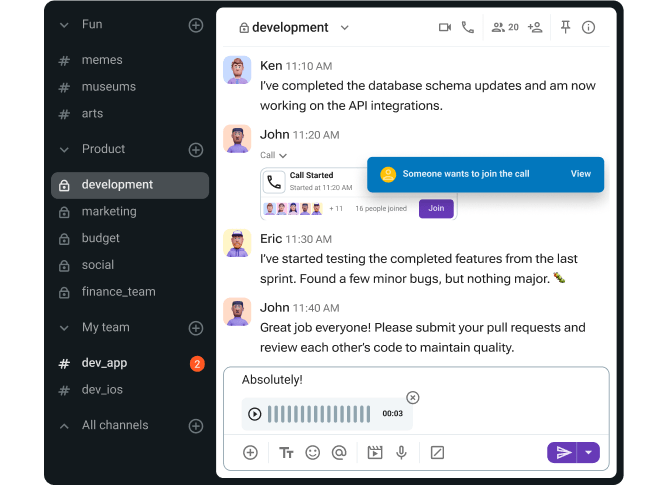À première vue, le processus de communication semble simple : vous contactez quelqu'un, il comprend ce que vous voulez dire et réagit de manière appropriée.
Mais qu'en est-il de toutes ces interprétations erronées, de ces signaux manqués ou de ces moments où votre intention passe complètement inaperçue ?
Ces questions se posent parce que le processus de communication est en constante évolution et dépend de huit facteurs interconnectés.
Dans les prochaines sections, nous poserons les bases théoriques d'une communication efficace et explorerons comment les appliquer pour communiquer plus efficacement au travail.
Nous entendrons également des experts qui nous feront part de leurs conseils éprouvés pour améliorer le processus de communication et éliminer les malentendus dans la communication.
Nous espérons que ces conseils vous aideront à résoudre les principaux problèmes de communication de votre équipe, à éviter toute confusion et à minimiser les reprises.
Êtes-vous prêts? C'est parti !

Qu'est-ce que le processus de communication ?
Le processus de communication englobe une séquence d'actes nécessaires à une communication efficace. Ces actes garantissent la transmission réussie du sens entre au moins deux participants, les aidant à se comprendre sans problème.
Cependant, il n'est parfois pas aussi simple qu'il n'y paraît à première vue.
En réalité, une communication efficace requiert une attention particulière aux huit facteurs interconnectés qui composent le processus. Lorsqu'il est correctement suivi, le processus de communication peut garantir que le message voulu est transmis et compris sans erreur d'interprétation ni confusion.
On va parler de la communication et de ses éléments formatifs pour mieux comprendre le processus.
Quels sont les 8 éléments du processus de communication ?
Dans le livre The Process of Communication : An Introduction to Theory and Practice, le théoricien de la communication David K. Berlo souligne que la communication, comme tout autre processus, est dynamique et en constante évolution.
Essentiellement, cela signifie que le sujet, le ton de la voix et le langage corporel varient selon l'interlocuteur. Cependant, certains éléments sont universels pour chaque interaction.
Les huit éléments du processus de communication sont :
- La source (ou l'émetteur) — la personne qui engage la conversation,
- Le message — l'objectif de la communication initiée,
- Le canal — le moyen par lequel le message circule de la source au récepteur,
- Le récepteur — la personne ou le groupe de personnes qui reçoit et interprète le message,
- Le feedback — la réponse du récepteur au message,
- L'environnement — les contextes mentaux et physiques dans lesquels nous communiquons,
- Le contexte — la scène, le décor et les attentes des participants à la conversation, et
- L'interférence (le bruit) — tout ce qui déforme ou modifie le sens voulu d'un message.
Examinons maintenant de plus près comment tous ces éléments interagissent pour créer le processus de communication.
Comprendre cela vous aidera à décomposer la communication en étapes, afin d'identifier celles sur lesquelles vous ou votre équipe pourriez avoir besoin de travailler.
Comment fonctionne le processus de communication ?
Le processus de communication se déroule en 5 étapes. Les étapes fondamentales de toute conversation sont :
- Formation de l'idée,
- Codage du message,
- Transmission du message,
- Décodage du message et
- Feedback.
Le modèle suivant est également appelé modèle transactionnel de communication. Décomposer ces phases du cycle de communication vous aidera à mieux comprendre votre rôle dans la conversation et à améliorer vos compétences en communication.
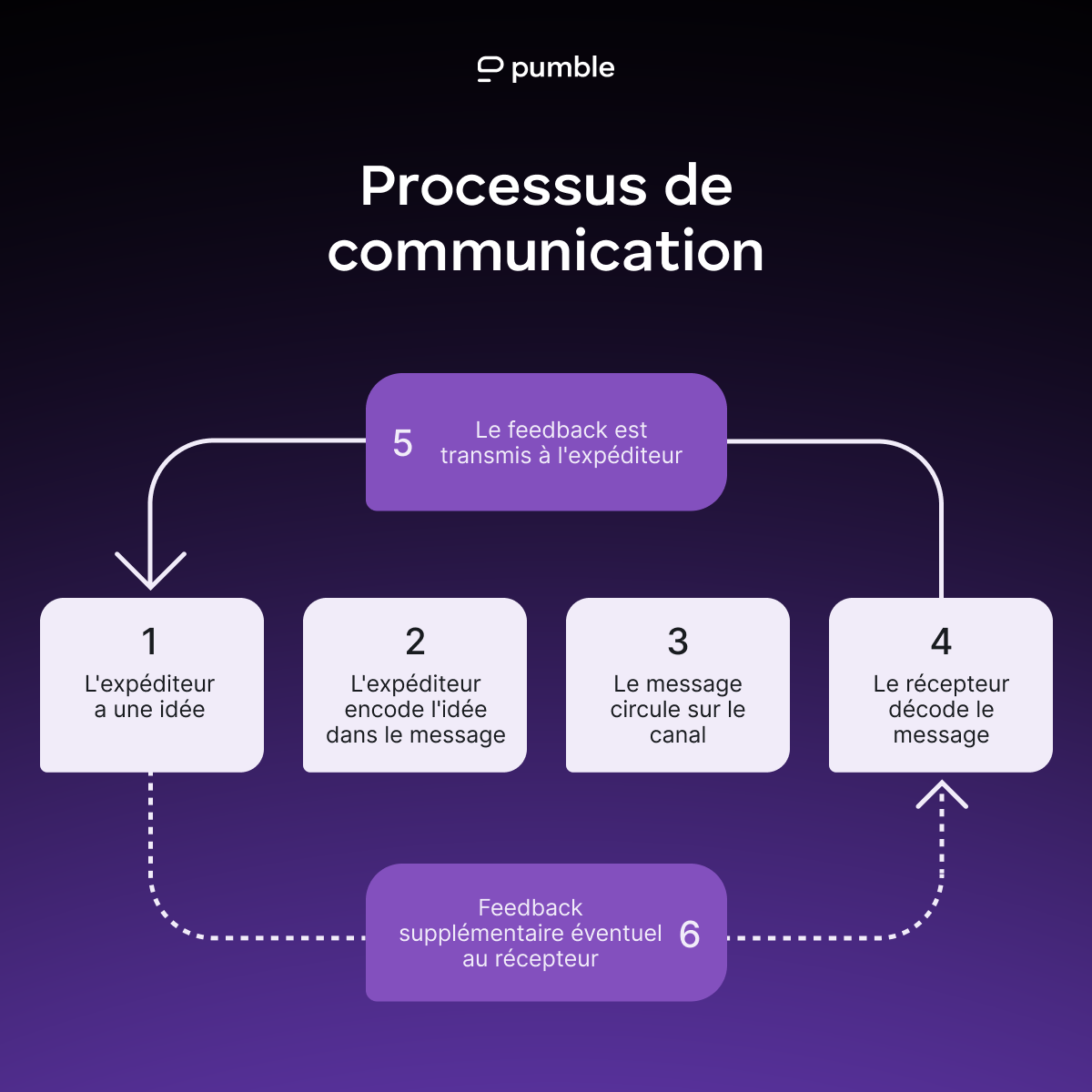
Étape n°1 : La source ou l'expéditeur a une idée (Formation de l'idée)
La communication commence par la source ou la personne envoie le message.
Plusieurs facteurs peuvent influencer le message que vous souhaitez transmettre. Avant de dire ou d'écrire quoi que ce soit, pensez à :
- Votre humeur et celle de votre interlocuteur,
- Vos positions au sein de l'entreprise, et
- Vos cultures potentiellement différentes.
La source doit toujours réfléchir à la réaction du destinataire ou du public au message.
L'une des compétences les plus précieuses d'un communicateur efficace est sa capacité à adapter son message afin de susciter une réaction positive.
Étape n°2 : La source encode l'idée dans un message (Encodage)
L'encodage consiste à transformer une idée en gestes et en mots qui ont la signification.
Cependant, différentes personnes associent différentes significations aux mêmes mots, ce qui peut donner lieu à des malentendus.
Selon Guffey et Loewy dans Business Communication : Process & Product, la mauvaise communication qui découle de significations différentes s'appelle le bypassing, et c'est l'un des pièges les plus courants de la communication professionnelle.
Pour éviter ces complications, utilisez autant que possible des mots courants et faciles à comprendre. Votre objectif, en tant que source, est de définir clairement le sens du message principal avec votre interlocuteur.
Cependant, même si vous êtes d'accord sur le sens, partager une langue avec quelqu'un ne signifie pas que vous partagez la même culture d'entreprise.
Voyons comment la langue et la culture peuvent entrer en conflit dans une conversation sur Pumble, une application de communication d'équipe.
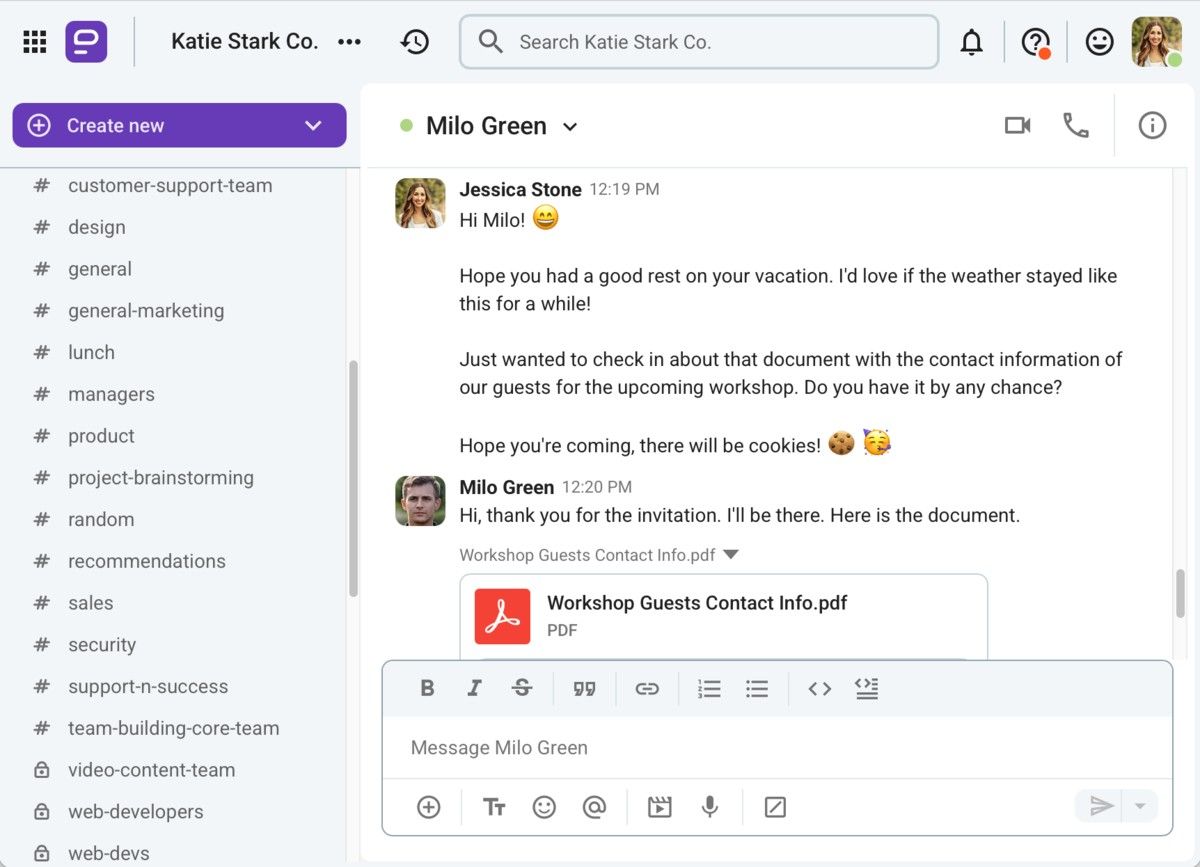
Jessica a envoyé un message à Milo, le nouveau responsable administratif qui a quitté le Royaume-Uni pour s'installer aux États-Unis. Jessica commence par des bavardages avant d'entrer dans le vif du sujet.
Bien que ce comportement soit considéré comme poli aux États-Unis, il peut déplaire aux personnes originaires de pays où il est d'usage d'aller à l'essentiel sans s'écarter du sujet.
En outre, Jessica utilise les termes “vacances” et “cookies.” Ces termes ne dérangent pas Milo, mais au Royaume-Uni, il est courant d'entendre “jours fériés” ou “biscuits”.
Enfin, la réponse de Milo est brève et ne s'aventure pas sur un terrain non professionnel. Cela peut paraître froid pour Jessica, qui est clairement habituée à différents types d'interactions.
🎓 Astuce Pro de Pumble
Pour découvrir comment d'autres différences, telles que la culture, la langue, les règles et les normes, influencent notre communication, consultez notre article :
Étape n°3 : Le message est transmis par un canal de communication (Transmission)
Au cours du cycle de communication, il est nécessaire de trouver le meilleur moyen de transmettre physiquement le message au destinataire. Le canal de communication est le support de transmission. Nous pouvons partager des messages via différents canaux, des appels téléphoniques et des photos aux emails ou aux applications de messagerie professionnelle.
Choisir un canal de communication efficace peut avoir un impact significatif sur la façon dont un destinataire interprète les messages verbaux et non verbaux.
Dans l'exemple ci-dessous, Emily partage le rapport annuel de performance avec ses collègues. Le ton du rapport, la mise en page et le design du document peuvent tous influencer la façon dont les collègues reçoivent le message.
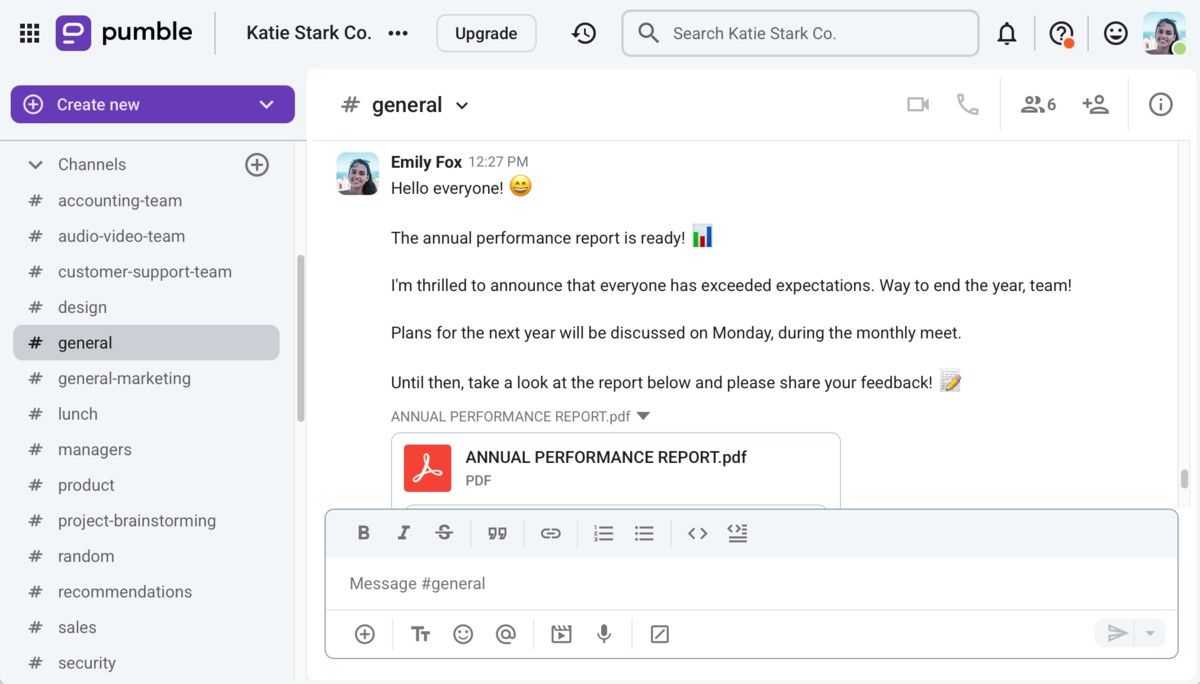
Partager des fichiers avec Pumble
Bien sûr, avant de choisir le canal le plus efficace, vous devez également tenir compte du bruit et de la manière dont il pourrait perturber la communication.
Voici un exemple de bruit et de la manière dont il pourrait perturber la communication :
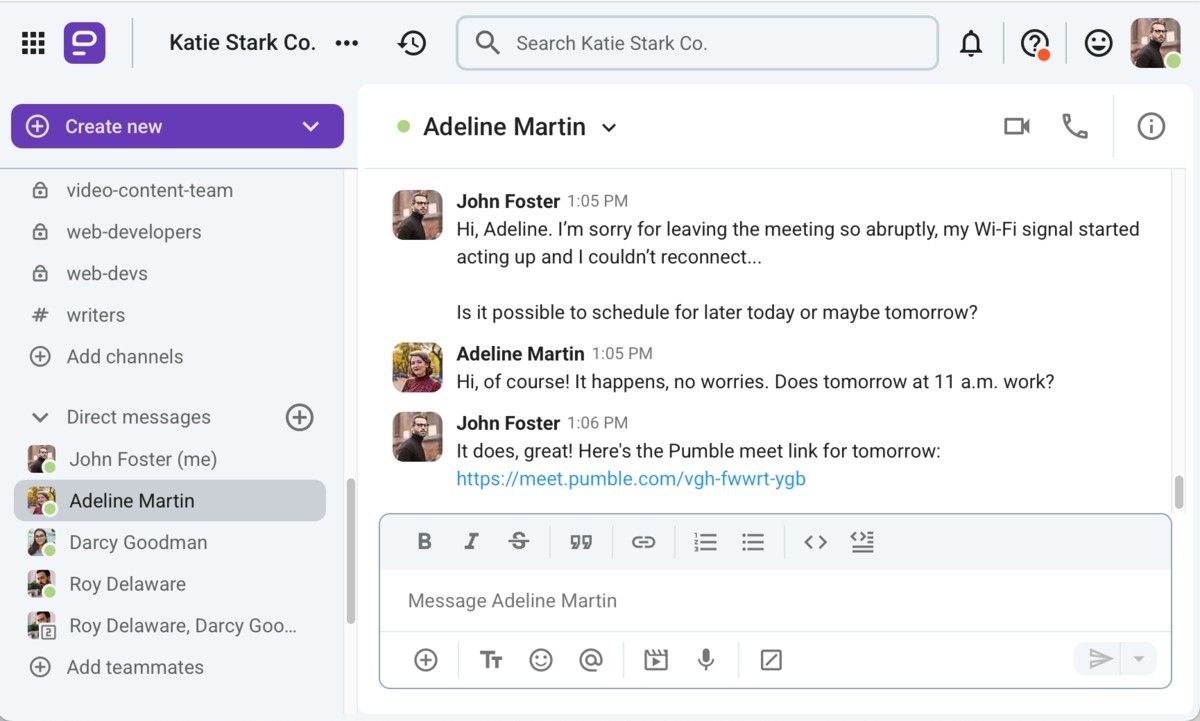
Les interférences peuvent prendre de nombreuses formes, allant des fautes d'orthographe dans les emails professionnels à une mauvaise connexion lors d'un appel vidéo virtuel.
Cependant, choisir un moment inapproprié pour envoyer un email ou planifier une réunion d'équipe pour un simple point est également considéré comme une interférence. Il est important d'en tenir compte lors de l'utilisation des outils numériques pour la communication interne.
Étape n°4 : Le récepteur décode le message (Décodage)
Le décodage intervient lorsque le récepteur analyse le message et convertit ses symboles pour en découvrir le sens.
Une communication réussie ne peut se faire que si le récepteur comprend le message de la source.
Étant donné que les expériences et les connaissances sont différentes, et que de nombreuses barrières à la communication peuvent s'y opposer, le décodage peut facilement devenir un processus complexe.
Les facteurs internes, comme le manque d'attention et les préjugés, peuvent entraîner des difficultés de décodage. Les facteurs externes, comme un environnement bruyant ou des problèmes techniques, peuvent également engendrer des malentendus ou en aggraver d'autres.
Communiquer sans problèmes techniques avec Pumble
Cependant, les obstacles sémantiques peuvent aussi souvent engendrer de graves problèmes de communication. Prenons l'exemple de l'annonce ci-dessous :
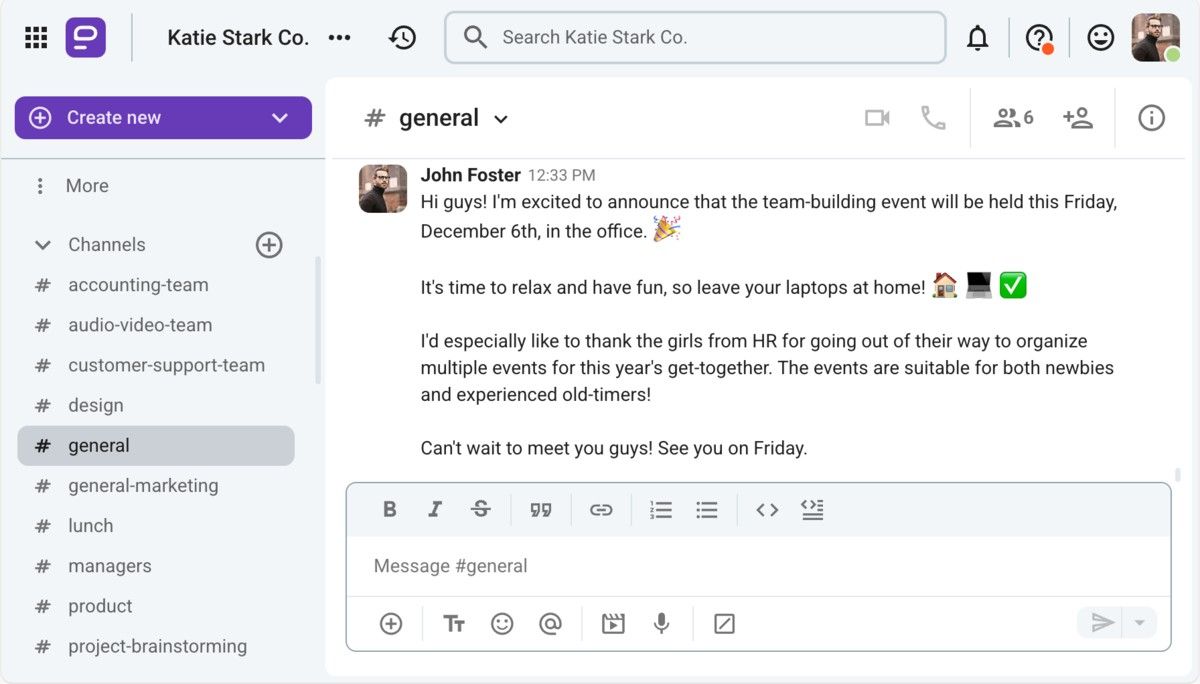
John a publié ce qu'il croit être une annonce passionnante concernant un événement d'entreprise à venir. Bien que ses intentions soient judicieuses, ses propos sont clairement à côté de la plaque.
Le fait qu'il ait choisi d'appeler les nouveaux employés « les petits nouveaux », les femmes « femmes », et les employés expérimentés « les anciens » risque d'offenser de nombreuses personnes
Ces choix de mots pourraient donc susciter de vives réactions qui empêcheraient les employés de se concentrer sur le message global.
Étape n°5 : Le feedback parvient à la source
Le feedback est le pilier de la communication et couvre les réponses non verbales et verbales de l'interlocuteur. Ces signaux permettent à la source de savoir comment la personne a reçu et compris le message.
Par exemple, lorsqu'un collègue demande « Comment se passe ta journée ? », vous pouvez répondre « Bien, merci. Et la vôtre ? ». Ou, si vous avez eu une journée particulièrement épuisante, vous pouvez sourire et hausser les épaules.
Dans les applications de communication d'équipe, vous pouvez envoyer un message, publier un commentaire ou utiliser un emoji pour montrer ce que vous ressentez.
Il est important de :
- Planifier votre discours,
- Choisir le bon moment, et
- Laisser à votre interlocuteur suffisamment de temps pour organiser ses pensées.
Comme les commentaires varient d'une personne à l'autre, il est judicieux d'encourager les retours d'information en milieu professionnel. Vous pouvez le faire avec des questions telles que « Est-ce que tout ce que j'ai dit est clair ? » ou « Avez-vous besoin d'éclaircissements sur quelque chose que j'ai mentionné ? »
🎓 Astuce Pro de Pumble
Dans le contexte de la communication, le feedback désigne la réponse immédiate d'une personne, mais vous avez probablement déjà rencontré des feedbacks concernant le travail ou le comportement d'une personne. Pour en savoir plus sur la manière de donner et de demander ce type de feedback en milieu professionnel, consultez :
Conseils pour améliorer le processus de communication
Maintenant que nous connaissons les 8 éléments et les 5 étapes de la communication, on va se concentrer sur la manière d'obtenir les meilleurs résultats possibles.
Conseil n°1 : Attention aux contournements
Bypassing est un phénomène qui se produit lorsque la source et le destinataire attribuent deux significations totalement différentes à un même mot ou à une même expression.
Par exemple, si vous venez de décrocher votre premier emploi après avoir obtenu votre diplôme universitaire, la mention de la « cadence de réunion » dans un message de votre supérieur peut vous déconcerter.
Vous pourriez immédiatement penser à la définition plus courante du mot « cadence », qui désigne l'inflexion de la voix. Mais votre responsable fait ici référence à la fréquence des réunions d'équipe, et il pourrait vous falloir un certain temps pour vous mettre d'accord.
La bonne nouvelle, c'est que la communication professionnelle n'a pas besoin d'être alambiquée. Vous pouvez éviter le contournement en :
- Évitant d'utiliser un jargon professionnel sur le lieu de travail,
- Utilisant un langage simple et clair, et
- Relisant vos messages et vos emails pour éliminer les fautes d'orthographe et les formulations vagues.
Conseil n°2 : Efforcez-vous d'être plus attentif à vos interlocuteurs
Même si une personne structure son message avec soin, ses efforts seront vains si l'autre personne n'est pas à l'écoute.
Heureusement, l'écoute active est une compétence et vous pouvez apprendre à l'exploiter à votre avantage dans la communication professionnelle.
Dans Communication in Business: Strategies and Skills, Judith Dwyer cite Gamble et Gamble (1996), qui ont identifié six comportements courants chez la plupart des auditeurs peu attentifs :
- Lanceur de fléchettes : remettre en question l'orateur et la validité de son histoire dès qu'il commet une erreur, aussi minime soit-elle.
- Oreille de porc : Dominer la situation de communication en insistant sur son récit et en empêchant les autres de donner leur version.
- Abeille : n'écouter que les parties de la conversation qui vous intéressent le plus et ignorer tout le reste.
- Cache-oreilles : détourner la conversation pour éviter d'être confronté à des informations spécifiques.
- Remplisseur des lacunes : trouver des informations supplémentaires pour prouver que vous avez entendu toute l'histoire, alors que vous n'en avez retenu qu'une partie.
- Hocheur de tête : faire semblant d'écouter alors qu’en réalité vous pensez à un tout autre sujet.
Parfois, nous faisons les choses de manière totalement involontaire. C'est pourquoi il est essentiel de prendre du recul et de s'efforcer de communiquer sans biais inconscients.
Selon Joanna Staniszewska, professionnelle chevronnée du marketing, de la communication et des RH, la communication est un échange à double sens, et l'écoute active est l'une des stratégies les plus efficaces :

« Écouter activement les autres favorise la confiance et la compréhension. Encouragez-les à :
- Être attentifs,
- Poser des questions et
- Confirmer leur compréhension lors des conversations.
🎓 Astuce Pro de Pumble
Envie de conseils pour devenir un auditeur présent et attentif ? Si oui, nous avons l'article qu'il vous faut :
Conseil n°3 : Créez un environnement propice au feedback
La mise en place de boucles de feedback stables a un impact positif sur l'engagement des employés, en créant un espace sûr où chacun peut s'exprimer librement au travail.
Si vous gérez une équipe, cette méthode peut être utile pour la reconnaissance des employés et la résolution des conflits avant qu'ils ne dégénèrent en problèmes majeurs.
Staniszewska a mentionné l'importance de feedback durable :

« Insistez sur la nécessité de mettre en place des mécanismes de feedback qui permettent aux individus d'évaluer en permanence l'efficacité de leur communication. Il peut s'agir de mécanismes formels, comme des enquêtes, ou informels, comme des échanges réguliers au sein de l'équipe ».
Pour créer une boucle de feedback positive, vous devez :
- Gérer vos émotions,
- Toujours mener la conversation avec empathie, et
- Donner du feedback en temps réel.
Voici un exemple de communication efficace et de création d'un tel environnement en tant que manager :
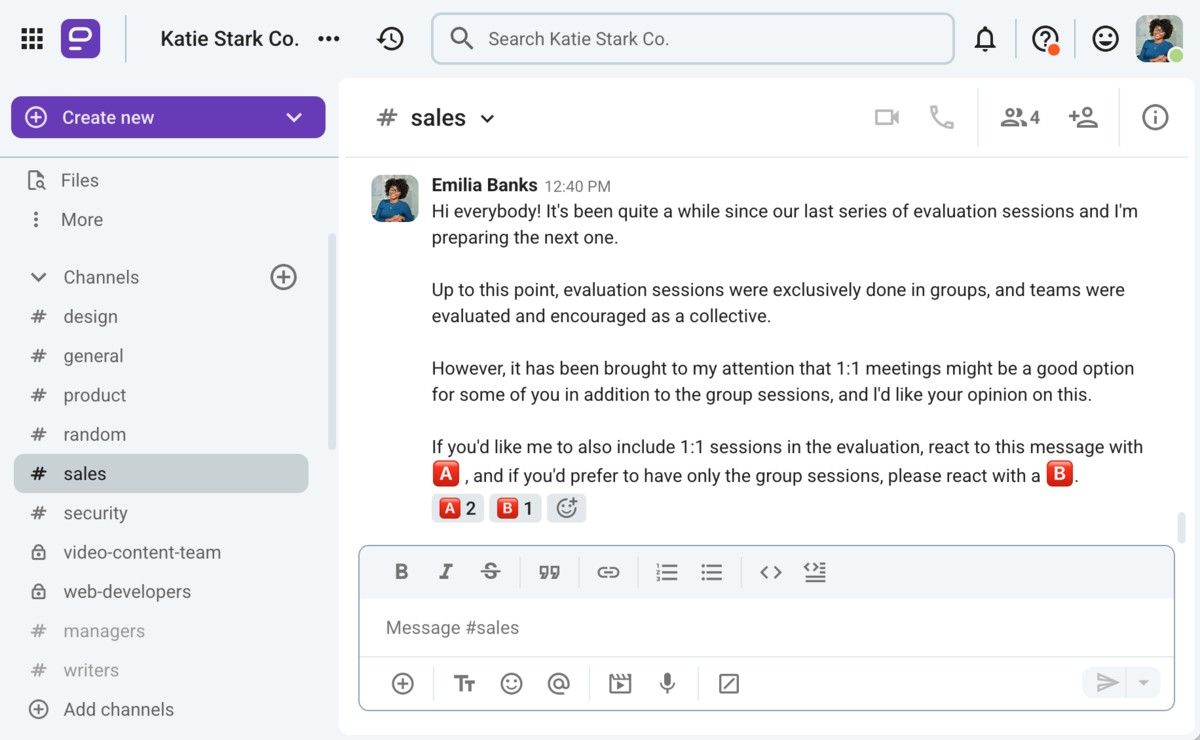
Lorsque vous demandez un feedback, n'oubliez pas de ne pas précipiter l'interaction, déclare Dawid Wiacek, coach en communication et en carrière pour cadres :

« Dans le monde des affaires actuel, la rapidité est souvent un avantage concurrentiel, mais pour réussir une communication, l'une des clés réside dans la lenteur. Pour vous assurer que votre interlocuteur a bien assimilé votre message, il est utile de lui demander de le résumer avec ses propres mots. »
Wiacek a également donné quelques conseils sur la manière de procéder correctement :

« Vous pouvez demander :
- Ce qui a marqué le message et ce qui ne l'a pas marqué,
- Ce qui a été perçu comme l'élément central et ce qui a été secondaire,
- Ce qui a été valorisant et peut-être surprenant.
L'objectif est de captiver le destinataire et de s'assurer que le message original a été traduit correctement et ne se perd pas dans la traduction. »
Donner du feedback plus efficacement avec Pumble
Conseil n°4 : Pensez aux différences d'origines
Bien que cela puisse être stressant, donner du feedback à ses collègues est essentiel dans la quasi-totalité des emplois.
Idéalement, nous donnons du feedback de manière constructive et valorisante, mais ce n'est pas toujours le cas. Même sans vouloir offenser quelqu'un, une situation peut survenir en raison de différences culturelles, professionnelles ou autres.
Prenons l'exemple de l'échange ci-dessous.
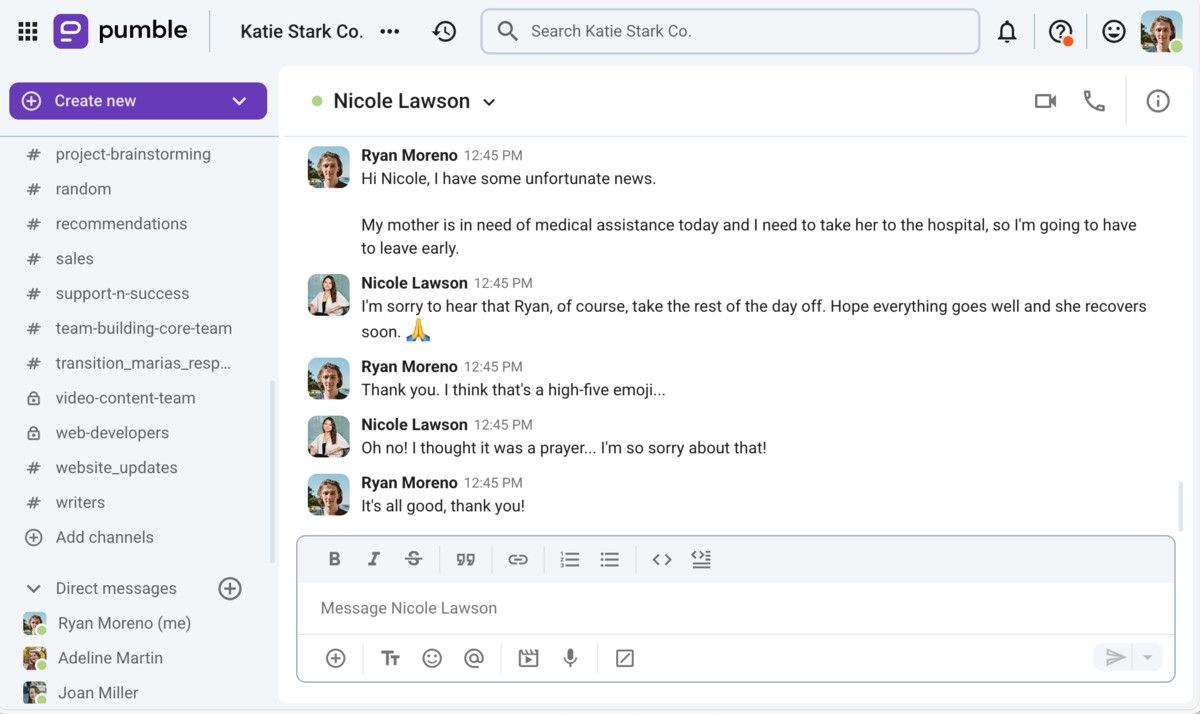
Nicole (des États-Unis) adresse ses meilleurs vœux à Ryan, qui travaille au Japon depuis six ans. Un léger malentendu survient, Nicole a supposé que Ryan interpréterait la signification d'un emoji de la même manière qu'elle.
Ce genre d'erreur est parfois facile à gérer, dans ce cas précis, Nicole et Ryan ont rapidement dissipé les tensions et ont pu passer à autre chose.
Cependant, il convient d'encourager stratégiquement tous les employés à s'adapter et à être attentifs aux différences potentielles, afin d'éviter toute tension ou dispute majeure.
Lors de notre entretien avec Joanna Staniszewska, elle a souligné l'importance de l'intelligence et de la sensibilité culturelles :

« La communication se déroule dans des environnements divers. Soulignez l'importance de la conscience et de la sensibilité culturelles. Encouragez les individus à adapter leur style de communication aux normes et attentes culturelles du public. »
Conseil n°5 : Comprenez les différents styles de communication
Comprendre votre style de communication préféré et l'adapter à celui de vos collègues peut faire toute la différence dans la collaboration de votre équipe.
Si quelqu'un se ferme brusquement pendant la communication, ce n'est peut-être pas à cause de quelque chose que vous avez dit ou fait intentionnellement.
Par exemple, alors que vous pensiez défendre votre idée avec assurance, votre collègue a peut-être eu l'impression que vous attaquiez subtilement la sienne.
Le problème principal ? La différence entre vos styles de communication.
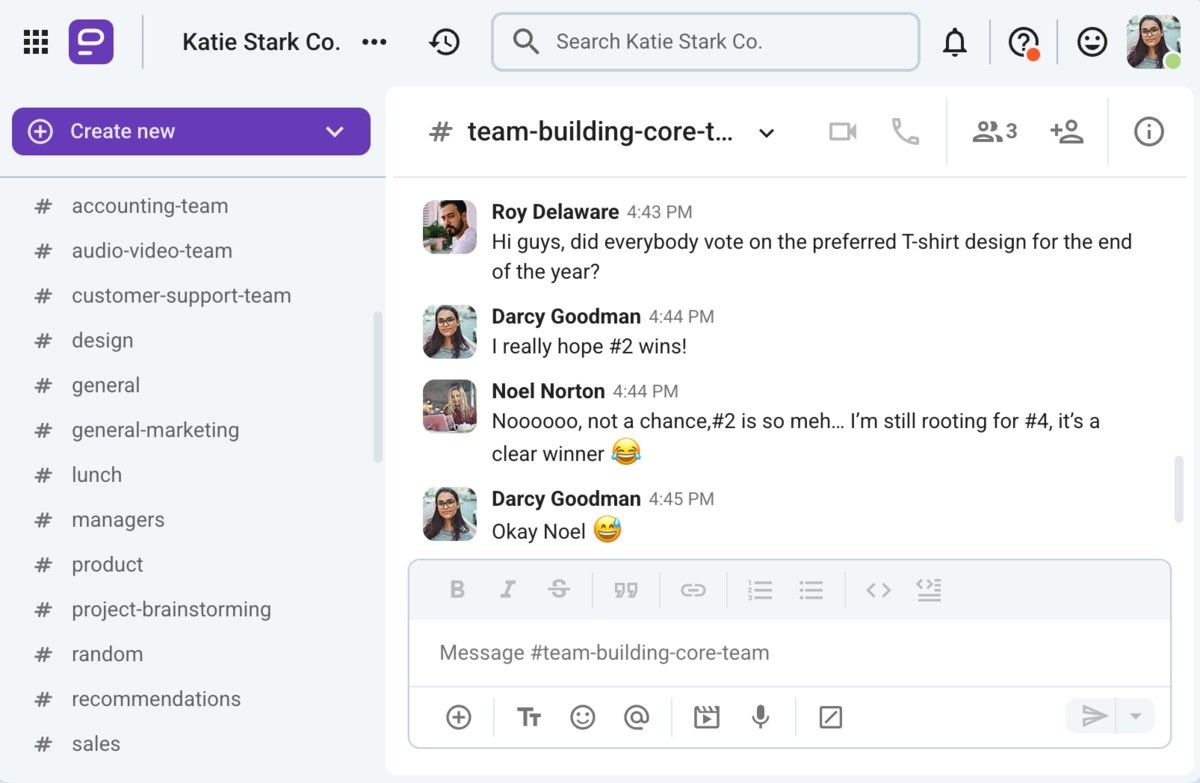
Connectez-vous avec votre équipe sur Pumble
Si vous vous trouvez souvent dans des situations similaires, une combinaison de conscience sociale et de conscience de soi peut vous aider à développer votre intelligence émotionnelle. Progresser sur ce point vous permettra de mieux maîtriser votre façon de parler et d'agir au travail.
Si vous avez besoin de plus d'aide, une autre stratégie consiste à vous inscrire à une formation de développement professionnel qui vous aidera à devenir un communicateur plus transparent et souple.
🎓 Astuce Pro de Pumble
Pour plus d'informations sur les différents styles de communication, ainsi que pour devenir plus flexible dans la communication professionnelle, consultez ce guide :
Conseil n°6 : Tenez compte de l'évolution démographique de la main-d'œuvre
En tant que chef d'équipe, vous devez savoir comment nouer des liens et collaborer avec des collègues de différentes générations, et inspirer les autres à faire de même.
Comme nous avons tous des habitudes et des préférences spécifiques, le fossé générationnel peut également créer des divergences entre notre comportement et celui de nos collègues plus âgés ou plus jeunes.
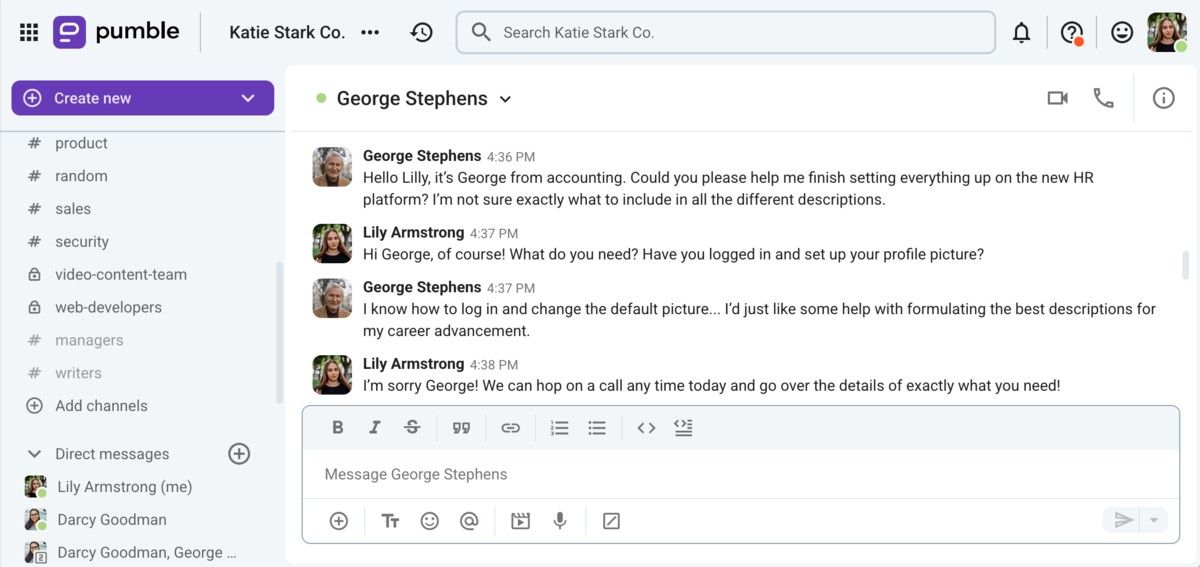
Pour créer un environnement propice à la communication et à l'intégration, il faut savoir gérer ces différences et s'abstenir de recourir à des stéréotypes.
Soyez parfaitement honnête quant à vos modes de communication préférés et respectez les limites des membres de votre équipe. Dès qu'ils remarqueront ces efforts, ils se sentiront plus à l'aise pour demander de l'aide ou pour vous contacter au sujet d'une tâche.
🎓 Astuce Pro de Pumble
Vous souhaitez en savoir plus sur l'amélioration de la communication intergénérationnelle au sein de votre équipe ou de votre entreprise ? Consultez :
Pourquoi le processus de communication est-il important ?
Grâce à la façon dont nous communiquons, nous apprenons non seulement à avancer dans la vie, mais aussi à nouer des relations stables.
Comprendre la communication signifie que :
- Elle influence notre perception des autres et de nous-mêmes,
- Elle influence notre façon d'apprendre, et
- Elle nous aide à donner le meilleur de nous-mêmes.
Quand vous travaillez en équipe, votre façon de communiquer peut donner une image positive de vous-même et de vos collègues. Un style de communication empreint de professionnalisme et de respect facilite grandement la conclusion d'accords et la négociation.
Associée à une excellente éthique de travail, une bonne communication est un atout majeur pour accéder à un poste de leader. De plus, si vous décidez de changer d'entreprise, de solides compétences en communication orale et écrite amélioreront considérablement vos perspectives d'emploi.
🎓 Astuce Pro de Pumble
Si vous faites un faux pas en rejoignant une nouvelle équipe, une bonne communication peut vous aider à aplanir les problèmes persistants. Mais pour éviter ces situations embarrassantes et apprendre à faire une bonne première impression, consultez l'article de blog ci-dessous :
Utilisez Pumble pour simplifier la communication de votre équipe
Maîtriser le processus de communication et son importance vous permettra d'avancer dans le développement de votre équipe.
Dans ce contexte, intégrer un outil conçu pour simplifier la communication vous permet d'optimiser vos canaux de communication et de favoriser des liens constructifs au travail.
Pour ce faire, Pumble est la solution idéale — l'application de communication d'équipe tout-en-un.
Pumble simplifie la communication des équipes hybrides, à distance et sur site grâce à des fonctionnalités qui optimisent les communications écrites et orales de votre équipe, telles que :
- Canaux – espaces dédiés pour simplifier la communication en notifiant rapidement des groupes de personnes,
- Fils de discussion – réponses aux messages pour naviguer entre les fils dans les canaux (idéal pour les boucles de feedback),
- Messages directs – pour les conversations individuelles et les références futures,
- Visioconférence – pour les conversations d'équipe en face à face et renforcer la confiance grâce au retour visuel,
- Enregistrement des réunions – pour revoir les conversations d'équipe importantes et éliminer les biais inconscients,
- Historique des messages illimité – pour accéder aux messages depuis la création de votre espace de travail et affiner votre processus de communication,
- Partage de fichiers avec recherche complète – pour retrouver les documents importants partagés par votre équipe depuis le premier jour et optimiser la diffusion de l'information.
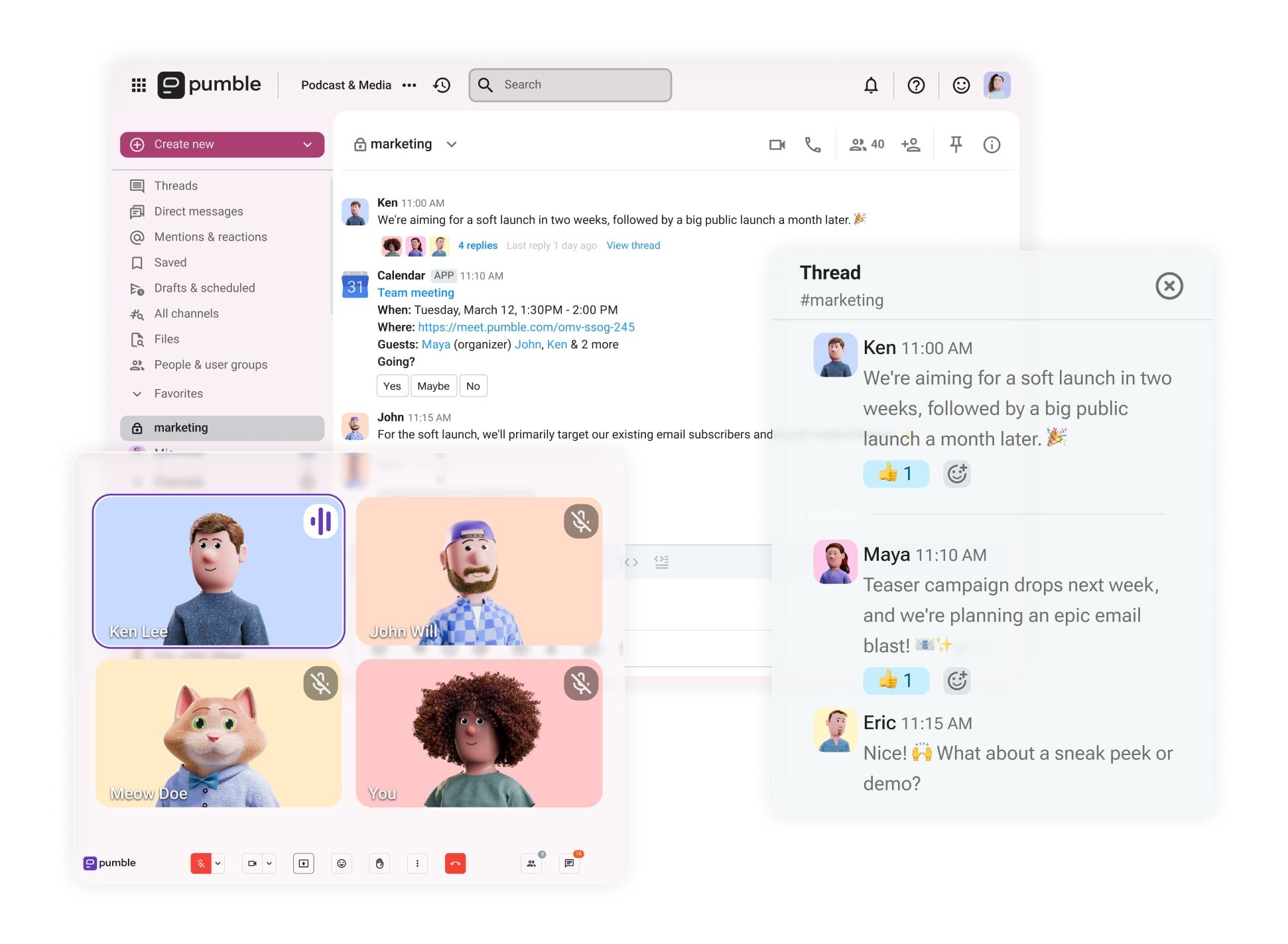
Grâce à son interface intuitive et à ses fonctionnalités de messagerie en temps réel, Pumble répond aux principaux défis de communication, tels que la surcharge d'informations et le cloisonnement des canaux. Pumble remplace les emails et devient une plateforme de communication tout-en-un hautement personnalisable (vous aidant à contourner la surcharge d'informations) et vous permet de connecter tous vos collaborateurs via les canaux pertinents (pour réduire les risques de cloisonnement).
En intégrant Pumble à votre processus de communication, vous pouvez :
- Favoriser la transparence,
- Optimiser les flux de travail, et
- Améliorer la cohésion de l'équipe.
Simplifiez la communication de votre équipe dès aujourd'hui.
Comment nous examinons cet article : Nos rédacteurs et éditeurs vérifient les articles et les mettent à jour lorsque de nouvelles informations sont disponibles, afin qu'ils soient toujours d'actualité.
